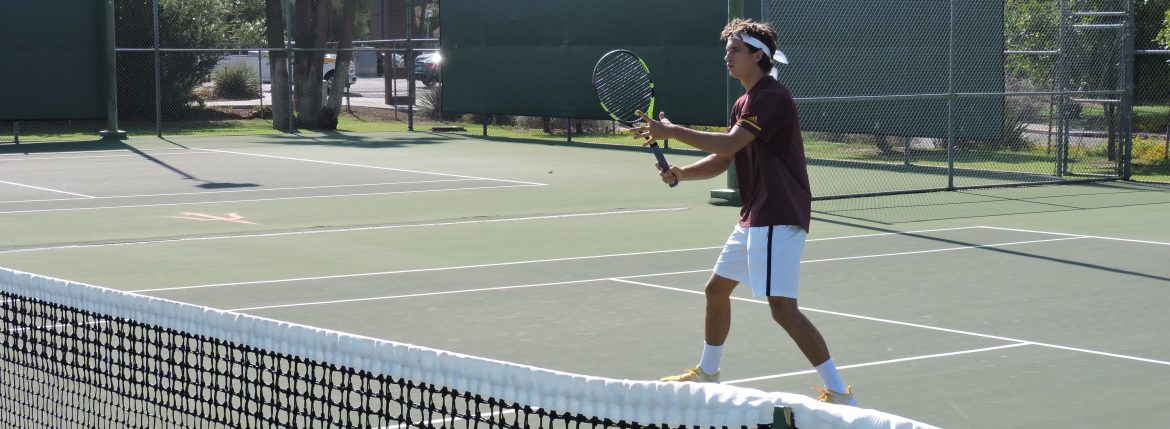
Benjamin Hannestad, Arizona State’s first signee for the revived men’s tennis program, works on his volleys at the Whiteman Tennis Center in Tempe. (Photo by Eric Newman/Cronkite News)
TEMPE — Following an eight-year period without a men’s tennis team, Arizona State is back with a highly regarded collection of international players.
In May of 2008, the university cut men’s tennis, along with wrestling and men’s swimming to save approximately $1.1 million in athletics spending per year. However, in May of 2016, due partly to a $1 million gift from ASU Vice President for University Athletics Ray Anderson, the team was reinstated.
Now it appears the rebuilding process could be expedited due to a talented group of prospects that recently began formal training on campus. The roster is a compilation of international players from countries — including France, Great Britain, Belgium and more — who make for easier recruits due to the less-stringent recruiting rules, and have skyrocketed the Sun Devils into the fifth-ranked recruiting class in the nation.
One of these foreign players, Benjamin Hannestad, a 20-year-old from Denmark, said it was his long-running relationship with coach Matt Hill on a past international recruiting trip that prompted him to come to a new program without an established tradition.
Hill was the coach at the University of South Florida for four seasons before joining the Sun Devils in 2016, and had originally recruited Hannestad to play in Tampa. In his time at USF, Hill had come in contact with Hannestad’s family in recruiting his older brother years before.
“I got to know the family through that process,” Hill said. “Naturally, when Benjamin started to think about college tennis, we already had a relationship.”
After a junior career in which he qualified for each of the four Junior Opens, reached the quarterfinals at the Junior French Championship at Roland Garros in 2015 and even played two professional matches for Denmark in the Davis Cup, Hannestad said his next step to a goal of reaching the professional tour was to latch on with Hill at USF.
However, Hannestad received a call one day that completely changed his college plans.
After leading USF to a third consecutive conference title, Hill told his new recruit in June of 2016 that he would be resigning from the school to come to ASU. Hannestad said he was “devastated.”
“It came like a shock. I didn’t see it coming at all,” he said. “And then I heard he took a program, well, that wasn’t really a program, at ASU. So he told me he was starting up a program from scratch, which first was very scary for me. I was like, “I shouldn’t do this.’ ”
Hill said he had no desire to break up the group he had worked so hard to build at USF, including the recruits that he had signed to play there, and encouraged many of them to honor their letters of intent and stay with the team.
However, Hannestad said that his desire in attending USF in the first place was to play under Hill, and, though frightening to be part of a program from its inception, he believed in the strength of the relationship the two had created, and thus chose to play tennis on the other side of the country.
“I wanted to be with Matt and (knew) that he was going to be the one to take me to the top, so I chose to come here with him,” Hannestad said.
With Hannestad finally at ASU, his reputation as a hard-working, talented player who is well-liked on the junior circuit could be a stepping stone for ASU to continue recruiting even more quality players, to eventually reach a level in which Hill grew accustomed to at USF: competing for conference championships, and possibly even more.
“Naturally, when he committed to coming here, it gave us a decent reputation when you start talking with other players,” Hill said. “They’re asking who’s on the team since they know we don’t have a team, and to be able to say someone like Benjamin is a huge plus for us.”
One of Hannestad’s teammates, Thomas Wright, of Beckenham, Great Britain, said part of what makes Hannestad so desirable to play along with is his skill, but also a professional, positive mindset that inspires everyone else to be at their best in practice.
“Mentally he’s always on it. You never look over the net and see a guy whose head’s down too often,” said Wright, ASU’s second player signed to ASU.
Wright said just being on the court near Hannestad makes the rest of the players better, and the coaches have been impressed with him since his arrival as well. He has an all-around game, but Hill said his ability to attack the net and win points with volleys is much higher than most players at the college level.
Michal Kokta, an assistant coach who coaches Hannestad individually most days, said that though they have some back-and-forth banter between points, and that Hannestad makes an active effort to enjoy his time on the court, he trains like a professional.
Since joining the team in January, there has been little opportunity for Hannestad and the rest of the players to get chances at competitive matches, and extra motivation in practice, his attitude remains the same.
“He really knows what he wants to achieve in tennis, and he’s willing to work on it every day. So he’s an extremely easy guy to coach. I don’t feel like we need to motivate him,” Kokta said.
Though not certain of what his end goal will look like at ASU, Hannestad hopes his decision to be the Sun Devils’ first signed player will be the first of many accomplishments in his tennis career.
“Everything I do is to get to the top and I think this is the stepping stone to make me go all the way,” he said.